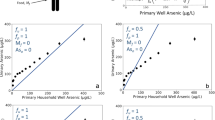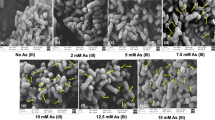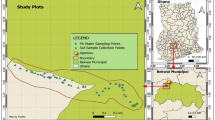Abstract
The relative contribution of dietary arsenic (As) to aggregate daily exposure has not been well-characterized, especially in relation to the current EPA maximum contaminant level (MCL) of 10 p.p.b. for As in drinking water. Our objectives were to: (1) model exposure to inorganic and total As among non-seafood eaters using subject-specific data, (2) compare the contribution of food, drinking and cooking water to estimated aggregate exposure in households with variable background tap water As levels, and (3) describe the upper distribution of potential dose at different thresholds of tap water As. Dietary As intake was modeled in regional study populations and NHANES 2003–2004 using dietary records in conjunction with published food As residue data. Water As was measured in the regional studies. Among subjects exposed to tap water As >10 p.p.b., aggregate inorganic exposure was 24.5–26.1 μg/day, with approximately 30% of intake from food. Among subjects living in homes with tap water As ≤10, 5 or 3 p.p.b., aggregate inorganic As exposure was 8.6–11.8 μg/day, with 54–85% of intake from food. Median inorganic As potential dose was 0.42–0.50 μg/kg BW/day in subjects exposed to tap water As >10 p.p.b. and less than half that among subjects exposed to tap water As ≤10 p.p.b. The majority of inorganic and total As exposure is attributable to diet in subjects with tap water As <MCL. Further research is needed to determine the potential toxicity and need for regulation of As in foods.
This is a preview of subscription content, access via your institution
Access options
Subscribe to this journal
Receive 6 print issues and online access
$259.00 per year
only $43.17 per issue
Buy this article
- Purchase on SpringerLink
- Instant access to full article PDF
Prices may be subject to local taxes which are calculated during checkout


Similar content being viewed by others
References
IARC. Arsenic in drinking water. International Agency for Research on Cancer (IARC) Monographs 2004; 84: 229. Retrieved from http://www.inchem.org/documents/iarc/vol84/84-01-arsenic.html.
Chen CL, Chiou HY, Hsu LI, Hsueh YM, Wu MM, Wang YH et al. Arsenic in drinking water and risk of urinary tract cancer: a follow-up study from northeastern Taiwan. Cancer Epidemiol Biomarkers Prev 2010; 19: 101–110.
Lewis DR, Southwick JW, Ouellet-Hellstrom R, Rench J, Calderon RL . Drinking water arsenic in Utah: a cohort mortality study. Environ Health Perspect 1999; 107: 359–365.
Meliker JR, Wahl RL, Cameron LL, Nriagu JO . Arsenic in drinking water and cerebrovascular disease, diabetes mellitus, and kidney disease in Michigan: a standardized mortality ratio analysis. Environ Health 2007; 6: 1–11.
Medrano MA, Boix R, Pastor-Barriuso R, Palau M, Damian J, Ramis R et al. Arsenic in public water supplies and cardiovascular mortality in Spain. Environ Res 2010; 110: 448–454.
NRC Arsenic in Drinking Water: 2001 Update. Free Executive Summary. Retrieved from http://www.nap.edu/catalog/10194.html.
WHO. Evaluation of certain contaminants in food. World Health Organ Tech Rep Ser 2011; 959: 1–105. Retrieved from World Health Organ Tech Rep Ser. website: http://www.ncbi.nlm.nih.gov/pubmed/21699062.
MacIntosh DL, Spengler JD, Ozkaynak H, Tsai L, Ryan PB . Dietary exposures to selected metals and pesticides. Environ Health Perspect 1996; 104: 202–209.
Yost LJ, Schoof RA, Aucoin R . Intake of inorganic arsenic in the North American diet. Hum Ecol Risk Assess 1998; 4: 137–152.
Meacher DM, Menzel DB, Dillencourt MD, Bic LF, Schoof RA, Yost LJ et al. Estimation of multimedia inorganic rsenic intake in the US population. Hum Ecol Risk Assess 2002; 8: 1697–1721.
Xue J, Zartarian V, Wang SW, Liu SV, Georgopoulos P . Probabilistic modeling of dietary arsenic exposure and dose and evaluation with 2003–2004 NHANES data. Environ Health Perspect 2010; 118: 345–350.
Slayton TM, Beck BD, Reynolds KA, Chapnick SD, Valberg PA, Yost LJ et al. Issues in arsenic cancer risk assessment. Environ Health Perspect 1996; 104: 1012–1018.
Kurzius-Spencer M . Modeling the effects of dietary arsenic and nutrient intake on urinary arsenic biomarkers, PhD thesis. University of Arizona: Tucson, AZ, USA. 2012.
Del Razo LM, Garcia-Vargas GG, Garcia-Salcedo J, Sanmiguel MF, Rivera M, Hernandez MC et al. Arsenic levels in cooked food and assessment of adult dietary intake of arsenic in the Region Lagunera, Mexico. Food Chem Toxicol 2002; 40: 1423–1431.
WHO. Arsenic and Arsenic Compounds. Environmental Health Criteria 2001; 224 . Retrieved from http://whqlibdoc.who.int/ehc/WHO_EHC_224.pdf.
Juhasz AL, Smith E, Weber J, Rees M, Rofe A, Kuchel T et al. In vivo assessment of arsenic bioavailability in rice and its significance for human health risk assessment. Environ Health Perspect 2006; 114: 1826–1831.
Stanek EJ, 3rd, Calabrese EJ, Barnes RM, Danku JM, Zhou Y, Kostecki PT et al. Bioavailability of arsenic in soil: pilot study results and design considerations. Hum Exp Toxicol 2010; 29: 945–960.
Lebowitz MD, O'Rourke MK, Gordon S, Moschandreas DJ, Buckley T, Nishioka M . Population-based exposure measurements in Arizona: a phase I field study in support of the National Human Exposure Assessment Survey. J Expo Anal Environ Epidemiol 1995; 5: 297–325.
Robertson GL, Lebowitz MD, O’Rourke MK, Gordon S, Moschandreas D . The National Human Exposure Assessment Survey (NHEXAS) study in Arizona—introduction and preliminary results. J Expo Anal Environ Epidemiol 1999; 9: 427–434.
O'Rourke MK, Van de Water PK, Jin S, Rogan SP, Weiss AD, Gordon SM et al. Evaluations of primary metals from NHEXAS Arizona: distributions and preliminary exposures. National Human Exposure Assessment Survey. J Expo Anal Environ Epidemiol 1999a; 9: 435–445.
Moschandreas DJ, Karuchit S, Berry MR, O’Rourke MK, Lo D, Lebowitz MD et al. Exposure apportionment: ranking food items by their contribution to dietary exposure. J Expo Anal Environ Epidemiol 2002; 12: 233–243.
Roberge J, O'Rourke MK, Meza-Montenegro MM, Gutierrez-Millan LE, Burgess JL, Harris RB . Binational arsenic exposure survey: methodology and estimated arsenic intake from drinking water and urinary arsenic concentrations. Int J Environ Res Public Health 2012; 9: 1051–1067.
Roberge J, O'Rourke MK, Meza-Montenegro MM, Gutierrez-Millan LE, Burgess JL, Harris RB . Binational Arsenic Exposure Survey: methodology and exploration of the relationship between estimated arsenic intake from drinking water and urinary arsenic concentrations. Int J Environ Res Public Health 2012; 9: 1051–1067.
NHANES. Documentation, Codebook, and Frequencies. Laboratory Component: Total and Speciated Arsenics. National Health and Nutrition Survey 2003-2004 Data Documentation 2007 Retrieved Nov 30, 2008, from www.cdc.gov/nchs/nhanes/nhanes2003-2004/L06UAS_C.htm.
NDSR Nutrition Data System for Research Software Version 2009. Minneapolis, MN: Nutrition Coordinating Center (NCC), University of Minnesota. Retrieved from http://www.ncc.umn.edu/products/database.html.
Schoof RA, Yost LJ, Eickhoff J, Crecelius EA, Cragin DW, Meacher DM et al. A market basket survey of inorganic arsenic in food. Food Chem Toxicol 1999; 37: 839–846.
USDA 2004 Food and Nutrient Database for Dietary Studies 1.0—Documentation and User Guide. Agricultural Research Service, Food Surveys Research Group: Beltsville, MD, USA, Retrieved from http://www.barc.usda.gov/bhnrc/foodsurvey.
USDA, 2006. Food and Nutrient Database for Dietary Studies 2.0. Agricultural Research Service, Food Surveys Research Group: Beltsville, MD, USA, Retrieved from http://www.ars.usda.gov/SP2UserFiles/Place/12355000/pdf/fndds/fndds2_doc.pdf#title.
O'Rourke MK, Rogan SP, Jin S, Robertson GL . Spatial distributions of arsenic exposure and mining communities from NHEXAS Arizona. National Human Exposure Assessment Survey. J Expo Anal Environ Epidemiol 1999b; 9: 446–455.
ATSDR 2007 Agency for Toxic Substances and Disease Registry Toxicological Profile for Arsenic (Update). Retrieved from http://www.atsdr.cdc.gov/toxprofiles/tp2.pdf.
ATSDR 2009, ATSDR Case Studies in Environmental Medicine: Arsenic Toxicity. (Course: WBCBDV1576). Retrieved from http://www.atsdr.cdc.gov/csem/arsenic/docs/arsenic.pdf.
Tao SS, Bolger PM . Dietary arsenic intakes in the United States: FDA Total Diet Study, September 1991–December 1996. Food Addit Contam 1999; 16: 465–472.
Egan SK, Tao SS, Pennington JA, Bolger PM . US Food and Drug Administration's Total Diet Study: intake of nutritional and toxic elements, 1991–96. Food Addit Contam 2002; 19: 103–125.
Gunderson EL . Dietary intakes of pesticides, selected elements, and other chemicals: FDA Total Diet Study, June 1984–April 1986. J AOAC Int 1995; 78: 910–921.
FDA. Total Diet Study—Study Design 2009. Retrieved 6 Nov 2011 from http://www.fda.gov/Food/FoodSafety/FoodContaminantsAdulteration/TotalDietStudy/ucm184232.htm.
MacIntosh DL, Williams PL, Hunter DJ, Sampson LA, Morris SC, Willett WC et al. Evaluation of a food frequency questionnaire-food composition approach for estimating dietary intake of inorganic arsenic and methylmercury. Cancer Epidemiol Biomarkers Prev 1997; 6: 1043–1050.
Meharg A, Hartley-Whitaker J . Arsenic uptake and metabolism in arsenic resistant and nonresistant plant species. New Phytologist 2002; 154: 29–43.
Diaz OP, Leyton I, Munoz O, Nunez N, Devesa V, Suner MA et al. Contribution of water, bread, and vegetables (raw and cooked) to dietary intake of inorganic arsenic in a rural village of Northern Chile. J Agric Food Chem 2004; 52: 1773–1779.
Lasky T, Sun W, Kadry A, Hoffman MK . Mean total arsenic concentrations in chicken 1989-2000 and estimated exposures for consumers of chicken. Environ Health Perspect 2004; 112: 18–21.
Liu WJ, Zhu YG, Hu Y, Williams PN, Gault AG, Meharg AA et al. Arsenic sequestration in iron plaque, its accumulation and speciation in mature rice plants (Oryza sativa L.). Environ Sci Technol 2006; 40: 5730–5736.
Meharg A, Lombi E, Williams PN, Scheckel KG, Feldmann J, Raab A et al. Speciation and localization of arsenic in white and brown rice grains. Environ Sci Technol 2008; 42: 1051–1057.
Signes A, Mitra K, Burlo F, Carbonell-Barrachina AA . Contribution of water and cooked rice to an estimation of the dietary intake of inorganic arsenic in a rural village of West Bengal, India. Food Addit Contam Part A Chem Anal Control Expo Risk Assess 2008; 25: 41–50.
Smith E, Juhasz AL, Weber J, Naidu R . Arsenic uptake and speciation in rice plants grown under greenhouse conditions with arsenic contaminated irrigation water. Sci Total Environ 2008; 392: 277–283.
Zavala YJ, Gerads R, Gorleyok H, Duxbury JM . Arsenic in rice: II. Arsenic speciation in USA grain and implications for human health. Environ Sci Technol 2008; 42: 3861–3866.
Sun GX, Williams PN, Zhu YG, Deacon C, Carey AM, Raab A et al. Survey of arsenic and its speciation in rice products such as breakfast cereals, rice crackers and Japanese rice condiments. Environ Int 2009; 35: 473–475.
Gilbert-Diamond D, Cottingham KL, Gruber JF, Punshon T, Sayarath V, Gandolfi AJ et al. Rice consumption contributes to arsenic exposure in US women. Proc Natl Acad Sci USA 2011; 108: 20656–20660.
Velez D, Montoro R . Arsenic speciation in manufactured seafood products. J Food Prot 1998; 61: 1240–1245.
Lorenzana R, Yeow A, Colman J, Chappell L, Choudhury H . Arsenic in seafood: speciation issues for human health risk assessment. Hum Ecol Risk Assess 2009; 15: 185–200.
Garelick H, Jones H, Dybowska A, Valsami-Jones E . Arsenic pollution sources. Rev Environ Contam Toxicol 2008; 197: 17–60.
Moore MM, Harrington-Brock K, Doerr CL . Relative genotoxic potency of arsenic and its methylated metabolites. Mutat Res 1997; 386: 279–290.
Styblo M, Del Razo LM, Vega L, Germolec DR, LeCluyse EL, Hamilton GA et al. Comparative toxicity of trivalent and pentavalent inorganic and methylated arsenicals in rat and human cells. Arch Toxicol 2000; 74: 289–299.
Hughes MF . Biomarkers of exposure: a case study with inorganic arsenic. Environ Health Perspect 2006; 114: 1790–1796.
Smith AH, Steinmaus CM . Health effects of arsenic and chromium in drinking water: recent human findings. Annu Rev Public Health 2009; 30: 107–122.
Williams PN, Price AH, Raab A, Hossain SA, Feldmann J, Meharg AA . Variation in arsenic speciation and concentration in paddy rice related to dietary exposure. Environ Sci Technol 2005; 39: 5531–5540.
Williams PN, Raab A, Feldmann J, Meharg AA . Market basket survey shows elevated levels of As in South Central U.S. processed rice compared to California: consequences for human dietary exposure. Environ Sci Technol 2007; 41: 2178–2183.
Thompson FE, Subar AF . Dietary assessment methodology. In Coulston AM, Boushey CJ (eds). Nutrition in the Prevention and Treatment of Disease 2nd edn. Elsevier Academic Press: Amsterdam, the Netherlands. 2008, pp 3–39.
Kurzius-Spencer M, O'Rourke MK, Hsu CH, Hartz V, Harris RB, Burgess JL . Measured versus modeled dietary arsenic and relation to urinary arsenic excretion and total exposure. J Expo Sci Environ Epidemiol 2013; 23: 442–449.
Acknowledgements
This study was completed in partial fulfillment of the requirements of the PhD program in Epidemiology at the University of Arizona, Mel and Enid Zuckerman College of Public Health. Funding for this research was provided by the US EPA Star Grant No. R83399201-0, The University of Arizona Specialized Program of Research Excellence (SPORE) (NIH/NCI CA95060), the Superfund Basic Research Program Grant (NIH ES-04940) and the Southwest Environmental Health Sciences Center Grant (NIH ES-006694).
Author information
Authors and Affiliations
Corresponding author
Ethics declarations
Competing interests
The authors declare no conflict of interest.
Rights and permissions
About this article
Cite this article
Kurzius-Spencer, M., Burgess, J., Harris, R. et al. Contribution of diet to aggregate arsenic exposures—An analysis across populations. J Expo Sci Environ Epidemiol 24, 156–162 (2014). https://doi.org/10.1038/jes.2013.37
Received:
Revised:
Accepted:
Published:
Issue date:
DOI: https://doi.org/10.1038/jes.2013.37
Keywords
This article is cited by
-
Long-term exposure to low-level arsenic in drinking water is associated with cause-specific mortality and hospitalization in the Mt. Amiata area (Tuscany, Italy)
BMC Public Health (2023)
-
Contribution of arsenic and uranium in private wells and community water systems to urinary biomarkers in US adults: The Strong Heart Study and the Multi-Ethnic Study of Atherosclerosis
Journal of Exposure Science & Environmental Epidemiology (2023)
-
A Clinical Perspective on Arsenic Exposure and Development of Atherosclerotic Cardiovascular Disease
Cardiovascular Drugs and Therapy (2022)
-
Mediating role of arsenic in the relationship between diet and pregnancy outcomes: prospective birth cohort in Bangladesh
Environmental Health (2019)
-
Ethnic, geographic and dietary differences in arsenic exposure in the multi-ethnic study of atherosclerosis (MESA)
Journal of Exposure Science & Environmental Epidemiology (2019)



